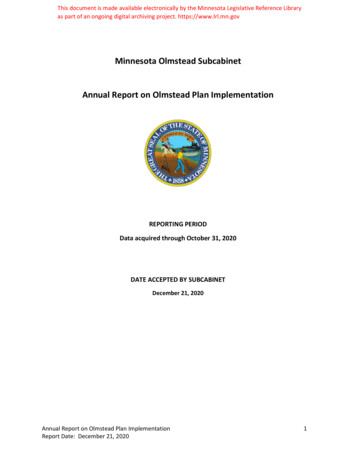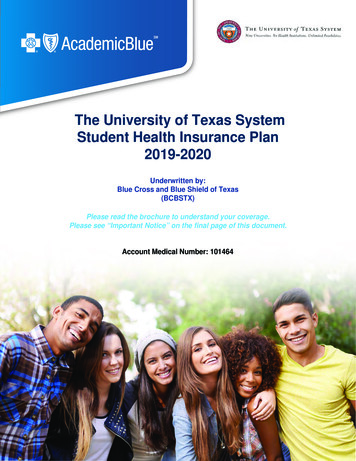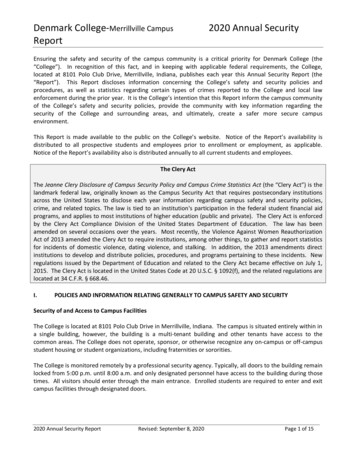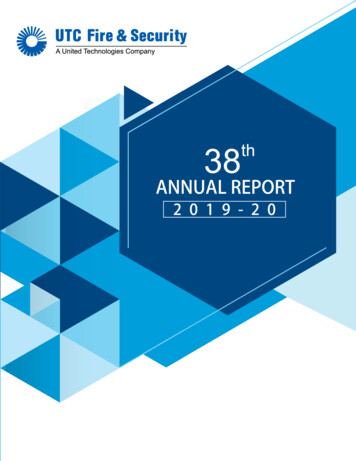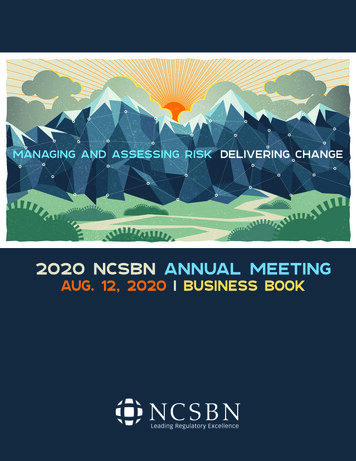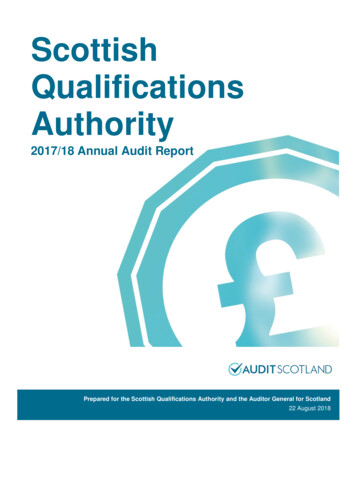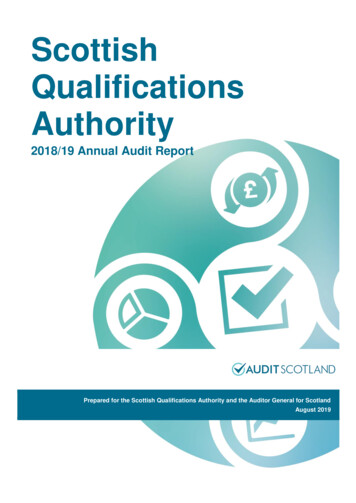
Transcription
2020 Annual Report on Requirements of theUniversity of Maryland Strategic Partnership Act6/30/21Implementation of the Strategic Partnership Act of 2016The University of Maryland Strategic Partnership Act of 2016 outlines a series of charges to theuniversities, and reporting to the Chancellor, Board of Regents and/or the Maryland General Assembly.This document provides a summary of those duties, and progress toward implementation.About the University of Maryland Strategic Partnership: MPowering the StateOverview: The University of Maryland Strategic Partnership is a formal collaboration between theUniversity of Maryland, Baltimore (UMB) and the University of Maryland, College Park (UMCP). Theframework for the Strategic Partnership began in 2012 when the University System of Maryland’s(USM) Board of Regents created an alliance between UMB and UMCP called MPowering the State. Thealliance was formalized and strengthened by the University of Maryland Strategic Partnership Act,enacted on October 1, 2016.Leadership: The University of Maryland Strategic Partnership is jointly managed by the President ofUMB and the President of UMCP. Each President is responsible for administration and leadership of hiscampus, and together responsible for accomplishing the initiatives and programs of the StrategicPartnership.A Joint Steering Council consisting of leaders from UMB and UMCP was appointed by the Presidents andcharged with achieving the goals of the Strategic Partnership Act. The Joint Steering Council overseesMPower operations and programs including funding allocations and development of partnershipopportunities.Programs: The University of Maryland Strategic Partnership: MPowering the State leverages thecomplementary strengths of UMB and UMCP to boost research, attract research dollars to the state,improve technology transfer, address workforce needs, create new educational opportunities, attractexceptional students, faculty and researchers, and solve important problems relevant to the people ofMaryland and the nation. The Strategic Partnership Initiative enables programs that would not beachieved by UMB or UMCP alone.1 Pag eUniversity of Maryland Strategic Partnership / 2020
Charge #1The Presidents jointly shall develop and implement a plan that encourages and promotesalignment, cooperation, and collaboration between the College Park campus and the Baltimorecampus. The plan shall: Identify all undergraduate and graduate academic and researchprograms that may benefit from alignment and collaboration between the campuses.A working group is charged with seeking new opportunities for collaboration and alignment ofundergraduate and graduate academic and research programs across the two campuses. In addition tolooking at areas where collaboration may be expanded, it also identifies obstacles or infrastructurebarriers that make it difficult for students to engage at the opposite university.Because UMB and UMCP’s programs are almost completely non-overlapping, the best opportunities foracademic program collaborations seem to be in creating seamless articulation of UMCP undergraduateprograms with UMB professional schools; examining enrollment marketing opportunities andrecruitment materials; identifying financial aid opportunities; streamlining the admission process forinternational students seeking dual degrees; and identifying opportunities for joint hires for faculty.UMB and UMCP have numerous collaborative academic and research programs in place, as well as 11dual degree offerings; 3 3 programs that allow students to attend UMCP for three years and thenmatriculate to spend three years at UMB’s schools of dentistry, law or pharmacy; guaranteed admissionpathways for UMCP students to the UMB School of Nursing; and a bachelor of science pathway to aPharmD at the UMB School of Pharmacy, designed to increase the number of pharmacists in the state.Recent efforts support the development and launch of new certificate and degree programs for UMBand UMCP students, including: An innovative joint UMB/UMCP master’s degree and stackable certificates in policing and publicsafety administration. The program was approved by the Chancellor of the University System ofMaryland, and launched in Fall 2020. A new Joint PhD Program in Bioengineering. The degree spans both institutions and offersstudents an opportunity to create and deliver engineering solutions to challenging clinicalproblems related to medicine, pharmacy, or dentistry. It launched in Fall 2019. An MOU was developed between the UMB School of Nursing and the UMCP InformationSchool (iSchool) related to developing a health informatics and data science specializationwithin the Bachelor of Science degree in Information Science. The MOU allows a limitednumber of reserved spots for UMCP students in the UMB Certified Nursing Leader program.2 Pag eUniversity of Maryland Strategic Partnership / 2020
Collaboration regarding technology-mediated English language learning through GlobalHealth. UMB and UMCP discussions focus on the development of a program to support theprofessional development of post-doctoral fellows in the area of global health. The programwould consist of support for continued English language learning for post-doctoral fellows aswell as support in effective science communication, both for academic and non-academicaudiences. This same group is investigating the development of a collaborative graduate-levelcertificate program around multilingual language learning and communication, in which atechnology-mediated English language instruction platform would provide personalizedinstruction to English language learners to allow it to be tailored to an individual’s Englishproficiency, academic needs, and professional interests. An interdisciplinary PhD in health professional education between the UMB Graduate Schooland the UMCP College of Education is in development, and a joint degree between the UMBSchool of Social Work and the UMCP School of Public Policy has launched, following thedevelopment of a MOU in August 2018.3 Pag eUniversity of Maryland Strategic Partnership / 2020
Charge #2The Presidents jointly shall develop and implement a plan that encourages and promotesalignment, cooperation, and collaboration between the College Park campus and the Baltimorecampus. The plan shall: Identify competitor state peers for the University of Maryland to beused in funding guidelines.Programs offered by UMB and UMCP are almost completely complementary, and make a unique andpowerful combination. This means UMB and UMCP have very few real peers in competitor states, andfinding a slate of true competitor state peers proved difficult. A committee of UMB and UMCP expertsnamed by the Joint Steering Council, studied at length the peer lists for UMB and UMCP as identifiedby the Maryland Higher Education Commission. After reviewing the peer lists and carefully exploringoptions such as combining competitor peers, the committee recommended leaving the peercomparison for the individual campuses in place as it is today. Thus, UMB and UMCP will continue tohave separate competitor state peers because any other option puts one or both campuses at adisadvantage in funding comparisons.4 Pag eUniversity of Maryland Strategic Partnership / 2020
Charge #3The Presidents jointly shall develop and implement a plan that encourages and promotesalignment, cooperation, and collaboration between the College Park campus and the Baltimorecampus. The plan shall: Promote effectiveness and efficiencies between the campuses,including potential savings in human resources, procurement, and information technology.An active committee of senior leaders from UMB and UMCP meets regularly to assess opportunities foralignment, cooperation and collaboration between the universities in four focus areas: procurement,finance, information technology (IT) and human resources (HR). The committee is actively examiningexisting systems and processes, as well as operations and contracts at UMB and UMCP, and throughoutthe University System. Proposed actions have completion dates ranging from one to 10 years.Accomplishments in 2020 are summarized below and on the following pages:Procurement InitiativesGoal: Increase savings targeted at a minimum of 5% or 17.5M, on approximately 350M in non-construction relatedspending, by leveraging the buying power of the two campuses while making the procurement process more efficient.Title/StatusDescriptionUpdate on ActivitiesMaster contractsIn progressDevelop programs to stimulate higher use ofmaster contracts. Whether shared or not,master contract usage on both campusesmust increase if other contract savingsinitiatives are to succeed. Education,training, process efficiency and ease of usewill be evaluated as mechanisms to increaseusage.UMB and UMCP’s procurement teams arepreparing a plan for development ofconsolidated master contracts. Bothcampuses continue to find synergy withthe use of contracts for common goodsand services.Joint Purchasing ofCOVID-19 PersonalProtective EquipmentClosedUMB and UMCP could potentiallycoordinate PPE purchases to obtain betterpricing and availability and to avoidcompeting with each other in themarketplace.It was determined that combinedpurchasing across campuses is notpractical due to the varied needs of eachcampus. UMB and UMCP have beensharing information on market conditionsand sources for difficult to obtain supplies.Vendor contractsIn progress5 Pag eCoalesce separate contracts held with thesame vendor. Wherever it is feasible, UMBand UMCP will hold one contract with anygiven merchant. The current focus is ondeveloping a joint contract forphotocopiers. Both campuses have manycontracts for copiers that are anticipatedto be consolidated into a single contract.UMB and UMCP continue to analyze dataand complete project planning for thisinitiative. A detailed plan was developedfor a consolidated contract forphotocopiers. The request for proposal isin final review and with an anticipatedissue date of November 19, 2020. Award ofthe consolidated photocopier contract isprojected for the spring of 2021.University of Maryland Strategic Partnership / 2020
Title/StatusDescriptionProcurement relatedinitiatives in other focusareasIn progressAssist with other procurement relatedinitiatives under SB1052 as needed.Update on ActivitiesEach procurement department is activelyengaged in several initiatives includinghuman resource tool consolidation.Finance InitiativesGoal: Identify and implement feasible alignment between the two campuses’ financial operations, including but notlimited to, financial systems, chart of account, policies, etc.Title/StatusTravel merchantcontractsIn progressDescriptionEvaluate opportunities to renegotiatecontracts with common travel merchants(air, rail, lodging, vehicle rental). Analyzesteps to be taken to merge buying powerbetween the two will be done. Execute onidentified steps.Update on ActivitiesUMCP is piloting the use of Concur traveland expense software as an initial steptoward full implementation. Improvedanalysis of spending and contract utilizationis expected be an outcome, enabling highernegotiated savings on existing contracts.UMB is staying abreast of this initiative andwill be working on identifying requirementsfor a travel and expense system as well asan alternative for processing purchasingcard transactions and reconciliation.Human Resources InitiativesGoal: Identify and implement feasible alignment between the two campuses’ Human Resource operations, includingbut not limited to, HR systems, job classifications, policies, etc.Title/StatusHR policies andprocessesIn progress6 Pag eDescriptionEvaluate campus policies andperform process review for thepotential of combining, and revisingthem for better integration betweencampuses. Both campuses will begina review of personnel policies todetermine if there are opportunitiesfor rewriting policy language togovern the needs of both campuses.Update on ActivitiesInitial HR business processes have been identifiedand are being evaluated to determine if processescan be combined for both campuses. This initiativecontinues to be delayed due to more pressingpriorities that have arisen from the pandemic.University of Maryland Strategic Partnership / 2020
Title/StatusDescriptionUpdate on ActivitiesHR technologyapplicationsIn progressReview HR technology potential foreach campus to migrate to one orthe other’s current HR subapplications. There are a number ofkey human resources systems thatwe have determined both campusescould share. The goal would be tohave personnel data maintained inone database, where somestandardization of processes couldbe established through systemworkflows and enhancements.I-9 Tracker: UMB is reviewing UMCP’s system.Joint purchase of HRERP systemClosedPurchase a web-based cloud hostedHR system that would includefunctionality to help both campusesmanage the employee full life cycle(hire to retire). The solution wouldbe to have one comprehensive HRsystem that includes all the HR keycomponents in the same system,including: applicant tracking, onboarding, position management, HRemployee appointment, time andattendance, total compensation,talent management, performancemanagement, succession planning,and off-boarding.UMB selected Oracle Cloud ERP for Financials andplans to implement Oracle for human capitalmanagement (HCM). After lengthy evaluation, UMCPselected Workday for finance, HCM, and students.Due to the very different needs of each campus, itwas not practical to use the same system for bothcampuses.Joint Learning andTalent DevelopmentTrainingIn progressCollaborate on learning and talentdevelopment training includingholding joint training sessions foremployees of both campuses.UMB and UMCP have collaborated on the followingactivities: Sharing trainers for cross-campus leadershipskills classes planned for fall/winter. Daily development emails and mini trainingmodules for all USM employees who are now onLinkedIn Learning Platform. Planning a daylong personal developmentconference for employees of both campuses.The event will also be open to other USMschools.Staff SharingIn progressUMB and UMCP’s HR offices arepreparing a memorandum ofunderstanding to facilitate sharingbenefits staff members. Staffmembers from both campus wouldbe trained so that they can serveemployees from both campuses. Thisarrangement would be helpful whenone campus is short staffed.The MOU is scheduled to be completed by the end ofDecember 2020.7 Pag eHireRight Background Checks: UMCP has adopted theBig Ten contract for conducting background checkswith HireRight. UMB is listed as an affiliate onUMCP’s contract. UMB is currently using HireRightwhile evaluating use of the UMCP contract. Bothcampuses plan to use standard background checkcontent for like employee classifications. Thisinitiative continues to be on hold pending a plannedupdate to the UMCP policy on background checkswhich has been delayed due to the pandemic.University of Maryland Strategic Partnership / 2020
Information Technology InitiativesGoal: Identify and implement feasible technology unification between the two campuses.Title/StatusDescriptionUpdate on ActivitiesAvailability of aunified identity andaccess managementinfrastructureIn progressBuild a unified identity and accessmanagement infrastructure that wouldallow individuals at UMCP and UMB to usetheir ID and password to access systems atthe other campus. UMB and UMCP shouldjointly move toward implementing theInternet2 TIER (Trust and Identity inEducation and Research). Thisinfrastructure framework has beendeveloped which allows individuals atUMCP and UMB to use their respectiveuniversity’s ID and password to accesssystems at the other campus. TheUMB/UMCP Seed Grant Program was thefirst application to be added to thistechnology unification framework andmore systems will be added as the identitymanagement project continues andevolves.No new activity during current reporting period.Cyber securityIn progressExplore opportunities for strengthening thecyber security program at both campuses.Both campuses have IT security expertswho work on securing and protectinguniversity systems and data assets.Collaborating on information securityservices would reduce costs based oncollective buying power and strengthenthese two areas of information security atboth campuses.Both campuses are exploring opportunities forstrengthening each campus’ cyber securityprogram.Kuali Research PreAward System datareportingIn progress8 Pag eUMB and UMCP will develop combinedresearch productivity reports to showresearch productivity as one institution.Approval was granted by the MPower SteeringCommittee to hire a data architect to helpdevelop a common research administrationreporting system. The position was filled and theindividual started work on August 17, 2020. Thedata architect is working with both campuses todevelop a system capable of generatingconsolidated research administration reportsthat will facilitate joint UMB and UMCPreporting to the National Science Foundation’sHigher Education Research and DevelopmentSurvey.University of Maryland Strategic Partnership / 2020
Title/StatusDescriptionUpdate on ActivitiesInternet1 and theMaryland Researchand EducationNetwork (MDREN)In progressThis network provides the primaryconnection to Internet1 (the commercialInternet). The network capacity andservices provided by MDREN are offered ataffordable prices.Internet 2 and theMid-AtlanticCrossroads (MAX)In progressInternet2 is the high-speed researchnetwork that is limited to Internet2members and affiliates.UMB participates with UMCP and with the otherUSM institutions in MDREN. MDREN hasleveraged the collective partnerships of USMinstitutions to provide network bandwidth andnetwork redundancy at significantly discountedrates.UMB connects to the Internet2 networkbackbone via the Mid-Atlantic Crossroads (MAX)which is operated by UMCP. This high-speedInternet2 network is used extensively by UMBand UMCP students, faculty and staff every day.UMB and UMCP have developed a cooperativearrangement with the MAX, where UMB isprovided access to this network and in exchangefor this access, UMCP is permitted to keep MAXnetwork equipment in the 300 West LexingtonStreet computing facility at UMB. Thiscooperative arrangement has greatly benefitedboth campuses.Maryland EducationEnterpriseConsortium (MEEC)In progressUMB and UMCP are collaboratingextensively with other USM institutions,other higher education institutions, K-12schools and leveraged the buying power ofthe Maryland Education EnterpriseConsortium (MEEC).Computing softwareIn progress9 Pag eUMCP and UMB will look for opportunitiesto share licenses and contracts forcomputing software to reduce costs andadministrative effort.UMCP explored adding UMB to its MatLabcontract. MatLab is used for computationalmathematics and specialized programming toanalyze data, develop algorithms, create modelsand applications. The MatLab software sharingeffort was not successful. MathWorks, thecompany that owns the MatLab software, didnot allow the UMB/UMCP software sharingagreement.Examples where IT savings have been realizedfor both campuses include: USM-wide Cisco contract for networkhardware maintenance New USM-wide Palo Alto contract fornetwork security equipment Internet2 for waived egress fees forMicrosoft Azure, Oracle Cloud, AmazonWeb Services, and for Duo multi-factorauthentication, and other Internet 2services MEEC to achieve significant volumediscounts for Microsoft licenses, Applehardware, Dell computers and servers, andother software including: Symantec, Adobe,InCommon, Terminal4, Carbon Black, andMicroFocus; and for consulting services viathe use of MEEC resellers that deploy andsupport enterprise applications (e.g.,instructional technology systems, ITsecurity-related systems)University of Maryland Strategic Partnership / 2020
Title/StatusDescriptionUpdate on ActivitiesUSM InformationSecurity CouncilIn progressUMB and UMCP participate with all otherUSM institutions on the USM InformationSecurity Council. The Security Councilshares information regarding securitypractices, procedures and policies andworks collaboratively on USM securitystandards which are checked forcompliance by USM, State, and third-partyauditors.The Council is working on a new set of standardsthat has a strong focus on federal securityguidelines. The Council receives and discussesinformation security updates and notices frommany sources including the REN-ISAC (Researchand Education Network – Information Sharingand Analysis Center) based at Indiana University.Technology relatedinitiatives in otherfocus areasIn progressAssist with other technology relatedinitiatives in other focus areas (e.g. HRsystem, financial system, etc.). Consultantand institutional resources will assess andmap current processes, business practices,and administrative functions at bothcampuses.As appropriate to the other conversations, ITresources are included in the discussions.10 P a g eUniversity of Maryland Strategic Partnership / 2020
Charge #4The Presidents shall actively seek collaboration with other institutions and entities,particularly in the Baltimore metropolitan region, as appropriate, to benefit the state. ThePresidents shall report annually to the University System of Maryland Board of Regents andthe USM Chancellor regarding collaboration with the City of Baltimore, Prince George’sCounty, and the City of College Park, in the area of community development.UMB and UMCP have long histories of community engagement and collaboration with otherinstitutions and entities in the Baltimore metropolitan area including the University of MarylandMedical System. In addition, UMCP manages the state extension service and the state experimentstations for the benefit of the people of the entire State of Maryland. The Presidents are committed toharnessing the power of the University of Maryland Strategic Partnership to expand collaborations inBaltimore, as well as in UMCP’s home community of College Park and Prince George’s County.Both UMB and UMCP directly impact the lives of students and faculty, and provide economic impact tothe communities where they reside. Both universities are engaged in on-going, major development thatincludes investments in new projects on and off campus in College Park and Baltimore. New buildings,designed to enhance teaching, research, and community interaction, will further attract students, faculty,and related businesses and in turn will generate activity and sales to support the local economy. Forexample, in early 2021, UMCP announced a new 300 million development at the campus’ entrance. It isthe latest component in an ongoing revitalization of greater College Park. The plan includes newapartments for 800 students, and 21,000 square feet of retail at Knox Road and Sterling Place.Other recent examples of community impact and collaboration include the following: The Center for Maryland Advanced Ventures (CMAV), created by the University of MarylandStrategic Partnership Act of 2016, has implemented a series of initiatives that encourage universitycreated or sponsored technology companies to locate and expand in Baltimore City. Since itsinception in 2017, 18 companies have received support through conditional grants, creating orretaining over 400 jobs in Baltimore City. Of these grants, 12 emerging companies received leasesubsidies to establish operations in Baltimore City, and six grants supported the direct expansion ofexisting companies. The University of Maryland S.A.F.E. (Support, Advocacy, Freedom and Empowerment) Center forHuman Trafficking Survivors is a Strategic Partnership initiative providing comprehensive directservices, research, and advocacy to victims of sex and labor trafficking. The Center is located inCollege Park. Since launching in mid-2016, the Center has developed a state-wide reputation forexcellence and timely intervention, and is supporting Maryland in its coordinated state, local andfederal effort against human trafficking. In addition to MPower, the Center is supported by grantsfrom Prince George’s County, the Governor’s Office of Crime Control and Prevention, and togetherwith Prince George’s County, by a grant from the U.S. Department of Justice.11 P a g eUniversity of Maryland Strategic Partnership / 2020
The Steering Council for the Strategic Partnership continues to explore ways to engage with theUniversity of Maryland Capital Region Health/Prince George’s Hospital Center. The acquisition of thehospital by University of Maryland Medical System and the opening of the new hospital in Largo,provide opportunities for new research, outreach and student training. Together UMB and UMCPhave deep experience with community health and health disparities, primary care deliverynetworks, ambulatory care, and clinical research. New programs may expand student training, attractand retain health and social service professionals to Prince George’s County, and improve healthcare provided to under-served populations in Maryland. Throughout 2020, the Strategic Partnership dedicated funding to cross-university academic programsand research collaborations designed to serve citizens in UMB and UMCP’s home communities andacross the state. A collaboration with the State of Maryland Department of Health (MDH) allowsstudents from across UMB and UMCP schools to work with MDH, and MDH to connect to the state’sresources at the universities. The program was expanded for summer 2021 to allow students fromUMCP and UMB to learn and to support MDH on research on the impact of community health workerin rural areas, and a second study regarding incentivizing provider service in Maryland’s underservedareas.12 P a g eUniversity of Maryland Strategic Partnership / 2020
Charge #5The University of Maryland Joint Steering Council consists of members appointed by thePresident of the College Park campus and the President of the Baltimore campus. The Councilshall: Develop guidelines for faculty appointments that are joint between UMB and UMCP;make recommendations to the Presidents on joint faculty appointments.The new collaborations in research and education between UMB and UMCP have fueled a desire tojointly hire new faculty and to create cross-campus appointments for existing faculty at bothinstitutions. University appointments may take the form of affiliate, secondary, adjunct, visiting or jointappointments, and require different levels of detail to implement. Guidelines will ensure that eachappointment is managed consistently, respecting the credential review that usually has already beendone on the home campus.The guidelines will state that all faculty appointments will be facilitated by the offices of the provost ateach institution. Faculty appointment letters will include a faculty member’s professorial rank andtenure status, the date on which the appointment is effective, the assigned Department, Center orInstitute, and the primary institution in which the appointment will reside. The primary institution’sresponsibilities will include administering compensation, benefits and administrative support; settingthe criteria for evaluation and conducting promotion, tenure and post-tenure reviews; and managingconflicts of interest. The professional conduct policies of each university will be followed while a facultymember is on the other institution’s campus.Discussions will continue regarding policies of promotion and tenure on each campus that willhopefully facilitate joint appointments at all levels. In addition, discussions will continue to developprinciples that will outline the structure for detailing these appointments to include workloadexpectations, resources, professional conduct, etc.13 P a g eUniversity of Maryland Strategic Partnership / 2020
Charge #6Establish the Center for Maryland Advanced Ventures (CMAV) on the UMB Campus inBaltimore City; Presidents jointly appoint Executive Director.The 11-page FY 2020 report from the Center for Maryland Advanced Ventures is included as an Appendixat the end of this document.*** Please proceed to the Appendix on page 22 to read the formal, submitted report.***14 P a g eUniversity of Maryland Strategic Partnership / 2020
Charge #7Establish the University of Maryland Center for Economic and Entrepreneurship (UMCEED) onthe UMCP campus; Presidents jointly appoint Executive Director.The University of Maryland Center for Economic and Entrepreneurship Development (UMCEED), basedat College Park, is focused on expanding academic and research programs that support economicdevelopment in the State of Maryland. UMCEED funds have been committed to a select and highlyimpactful group of programs.To date, UMCEED funding has capitalized on Maryland’s outstanding research and teaching programs inneuroscience through the formal establishment of the Brain and Behavior Initiative, which is solidifyingconnections across UMCP and between programs in College Park and Baltimore. UMCEED funds alsohave been used to strengthen and stabilize the internationally ranked (8th in the United States) programin Computer Science. Over 2 million in UMCEED funds have been invested in recruiting and retainingextraordinary tenure track faculty and academic support staff to instruct over 3,700 undergraduatemajors and 450 graduate students, allowing those students to graduate on time and meet the evergrowing workforce demands.A summary of UMCEED investments follows:Immersive Media Design MajorAfter several years of planning and collaboration, the UMCP Colleges of Arts and Humanities (ARHU) andComputer Mathematical and Natural Sciences (CMNS) jointly proposed to offer Bachelor of Science andBachelor of Arts degrees in lmmersive Media Design. The field of lmmersive Media Design encompassesa broad spectrum of practices drawing from both the creative arts and computing sciences.
UMB and UMCP have numerous collaborativ e academic and research programs in place, as well as 11 dual degree offerings; 3 3 programs that allow students to attend UMCP for three years and then matriculate to spend three years at UMB's schools of dentistry, law or pharmacy; guaranteed admission


